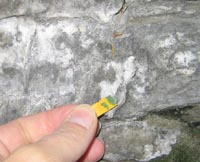The source of alkaline salt efflorescence (pH > 8) on monuments is always a building material (or restoration/conservation material) which is itself alkaline, such as cement, hydraulic lime or water glass (Schaffer, 1932 ; Arnold, 1985).
Therefore, if the measurement with a pH paper made on an efflorescence in situ or in laboratory gives an alkaline result (pH > 8), the search for the origin of the salts is very quickly orientated. On the contrary, if the pH is neutral or acid ( ≤ 8), the origin of the soluble salts can only be found after more sophisticated analyses and their origin could even be alkaline materials as the ones mentioned above.
 |
 |
| In situ measurement: – humidify the pH paper – hold it into the efflorescence or frict on it – read the value |
Laboratory measurement: – dissolve the salts in a drop of water – hold the pH paper into the drop – read the value |
Arnold, A. (1985). “Moderne alkalische Baustoffe und die Probleme bei der Konservierung von Denkmälern.” Natursteinkonservierung, Arbeitshefte des Bayerischen Landesamtes für Denkmalpflege, 31, 152-162.
Schaffer, R. J. (1932). “The Weathering of Natural Building Stones.” Facsimile of the 1932 edition , published by Construction Research communications Ltd, by permission of Building Research Establishment Ltd.